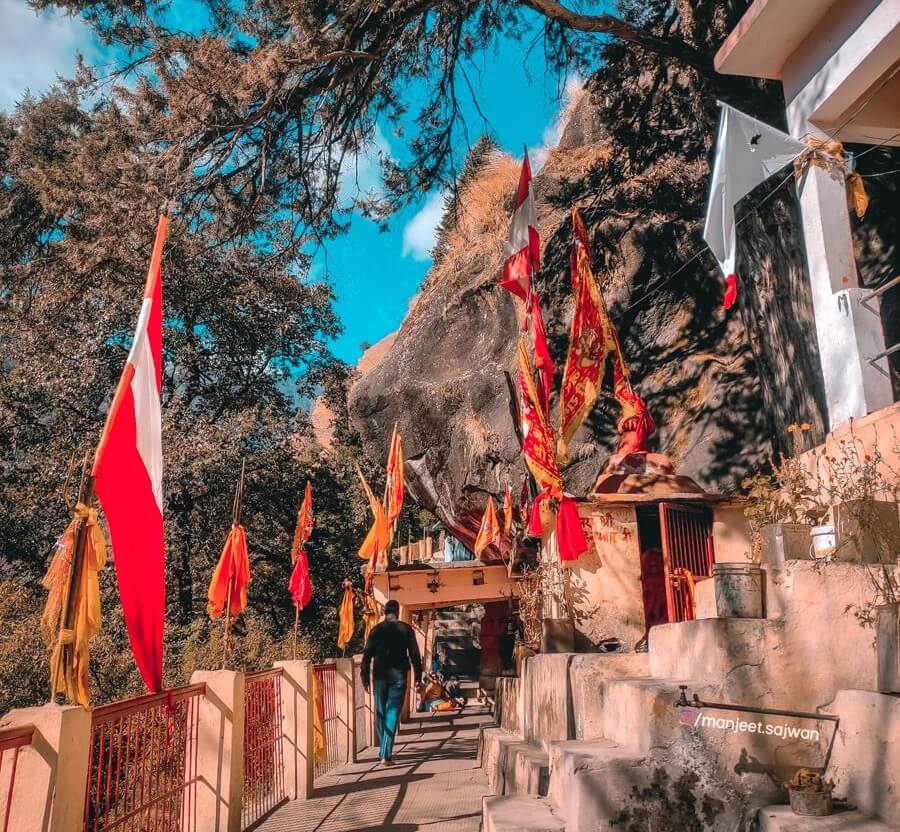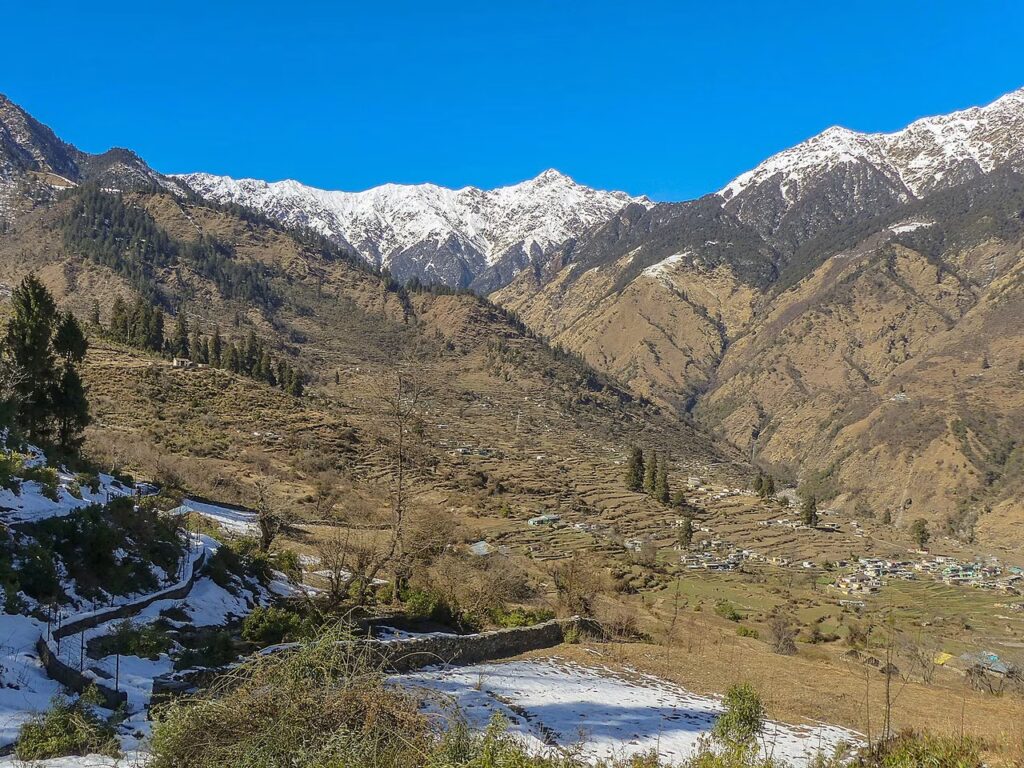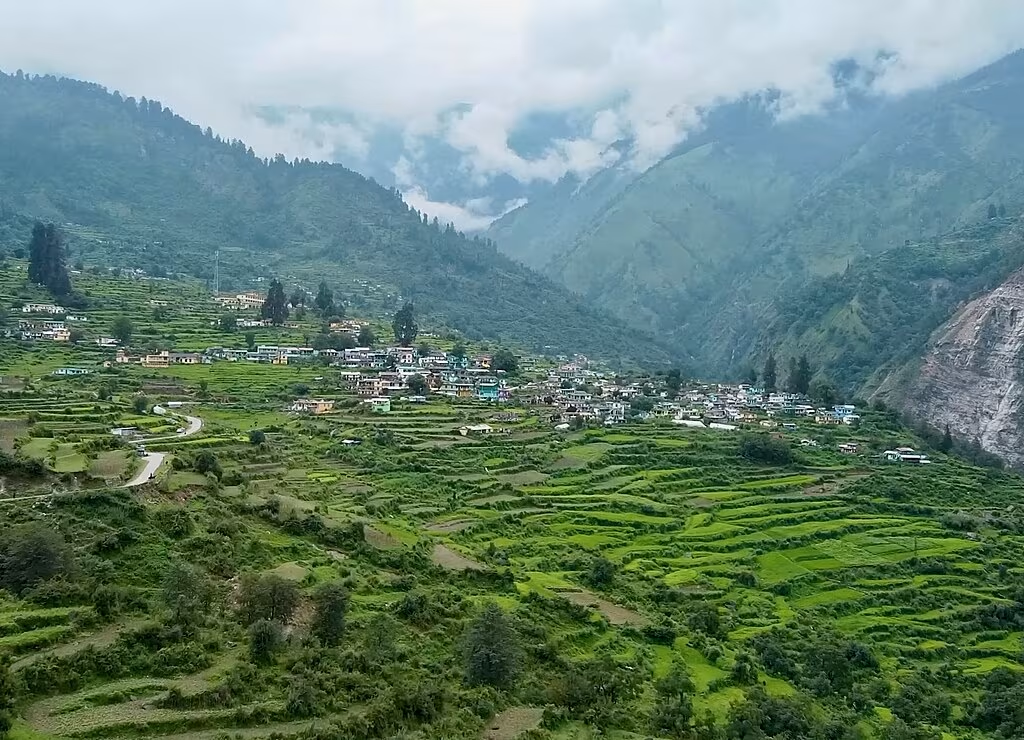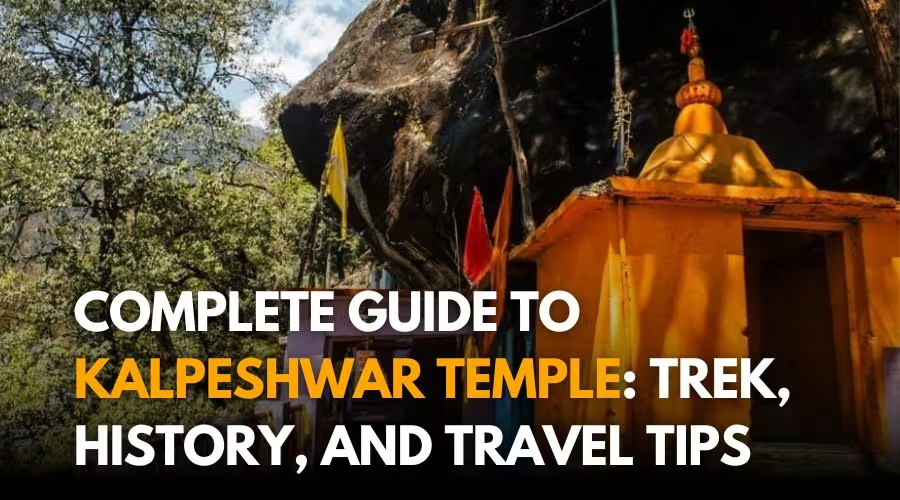The Urgam valley in the Garhwal Himalayas is the epitome of beauty, and the sacred abode of Lord Shiva at the Kalpeshwar Temple adds to it.
The Kalpeshwar or Kalpnath Temple is the fifth destination in the holy circuit of Panch Kedar Yatra. Located near the Kalpganga river, at an altitude of approximately 7,200 feet (2,200 metres), the Kalpeshwar temple is popular among both nature enthusiasts and pilgrims.
The hike to Kalpanath temple is one of the easiest among the Panch Kedar circuit. The town of Joshimath is the base camp for the Kalpeshwar temple, making it accessible to every pilgrim and hiker.
A part of the Panch Kedar circuit, the Kalpnanth temple is dedicated to Lord Shiva, with devotees worshipping his hair in the temple. It is also the only temple among the Panch Kedar holy circuit which remains open to pilgrims all year round. The temple is elegant in the simplest way possible and yet has some of the most intricate carvings. The place is filled with a divine aura of devotion and peace.
Find out more about the Kalpeshwar temple in this guide.

Table of Contents
Why visit Kalpeshwar?
The Kalpeshwar Mahadev Temple has something to offer to each of its visitors. For hikers and nature enthusiasts, the trek is filled with untouched valleys and dense woods. For pilgrims seeking divinity, the Kalpeshwar trek guides them to the abode of Lord Shiva, where the old Kalpvrikhsa tree is known for granting the wishes of the devotees.
The Kalpeshwar Temple also offers one of the easiest routes, with only a 1 km distance to the temple. Regardless, the route is abundant with potato farms and apple orchards, along with the flowing Kalpganga River. All of these add up to numerous serene yet charming views throughout the trek.
Historical and cultural significance.
The Panch Kedar circuit is associated with the legends of the Hindu epic, Mahabharata. According to the legend, the Pandavas sought Lord Shiva’s forgiveness after the Kurukshetra war, where they had committed violence towards their own cousins. However, Lord shiva was furious at the bloodshed and disguised himself as a bull in the Gawhal region of the Himalayas. With devoted searching from the Pandava brothers, Bhima recognised Lord shiva, in his bull form. Shiva, however, immersed himself in the ground, and later different parts of his body were found at different sites. The Pandavas founded temples dedicated to Lord Shiva at these sites, which are now the Panch Kedar temples.
Lord Shiva’s back (the hump of the bull form) appeared in Kedarnath; his face in Rudranath, his arms in Tungnath, his stomach and navel in Madhyamaheswar, and lastly, his hair locks at Kalpeshwar temple. Hence, pilgrims believe the Kalpeshwar temple to be a site for penance and forgiveness.
How to reach Kalpeshwar?
Since the temple is located in the fairly remote Garwhal Himalayas, most of the distance is covered with road travel and a short hike. Let’s find out more on reaching Kalpeshwar in the following general guide:
By Train
To reach the Kalpeshwar temple by train, you can start your journey by reaching either Rishikesh or Haridwar. These are the major cities nearest to the temple and are well-connected to other major Indian cities.
Rishikesh is the nearest railway station to Kalpeshwar temple. It is about 250 km from the temple, and the station has frequent trains to and from other major cities in India.
By Air
In Dehradun, the Jolly Grant airport is the nearest airport to the Kalpeshwar Temple. The distance between the temple and Jolly Grant airport is approximately 265 km.
By Road
To reach Kalpeshwar temple by road, Rishikesh is the most convenient starting point. From Rishikesh, you can follow this itinerary:
- Hire a local taxi to Kalpeshwar Temple. You can also make use of the Uttarakhand Transport bus or hire a shared cab to reach Helang.
- Helang is the base for the Kalpeshwar trek. It is located in Joshimath.
- After reaching Helang, you can take a local shared taxi to reach the Urgam village, the base camp of the trek.
A Short Hike
The hike to Kalpeshwar temple from the Urgam village is a short one. You can drive up to a certain point and then complete a 200-metre hike to reach the temple. Throughout the hike, you will come across vivid landscapes, a cave passage, and cross the Kalpganga river.
Best time to visit Kalpeshwar
The Kalpeshwar Temple is the only site in the Panch Kedar circuit that is open to pilgrims all year round. So, pilgrims can visit the temple any time of the year, without the worries of its opening and closing months.

However, there are a few months that can enhance the trek, while some can increase your hassles. The pilgrimage season, post-monsoon, and the summer months are usually the best times to visit the Kalpeshwar Temple. On the other hand, avoid visiting the temple in the monsoon and winter months. Find out more about these seasons and their effect on the Kalpeshwar trek below:
| Seasons | Months | Details |
| Pilgrimage season | May to October | The average temperature ranges between 16° C and 25° C. The weather is pleasant for trekking, along with accessible routes. |
| Summer season | May to June | The average temperature ranges between 16° C and 20° C. The temperature is comfortable for trekking with abundant greenery. |
| Post-monsoon season | September to October | The average temperature ranges between 10° C and 20° C. The transition to winter offers charming views and clear weather. |
Seasons to avoid
Let’s look at some seasons when you should avoid planning for a Kalpeshwar trek:
| Seasons | Months | Details |
| Monsoon seasons | July to September | Heavy rainfalls and occasional thunderstorms. Increased risks of landslides and dangers of slippery trekking trails. |
| Winter seasons | November to April | The average temperature plummets to 5° C and brings in moderate snowfall. Inaccessible trekking routes and difficulties in adventure activities. |

How difficult is the Kalpeshwar trek?
The short hike to Kalpeshwar Temple is easily accessible and fairly easy, offering convenient access to all the pilgrims. The trail is straightforward and passes through the Urgam valley. There is almost no steep ascent, and the route is paved for a comfortable walk. A short ascent across the river and along the waterfall leads up to the temple, and similarly, the trek back down is easy too. Despite the effortless trip to the temple, there are a few factors to consider. Find out about them in the next section.
How to prepare for the trip?
Regardless that the Kalpeshwar temple is easily accessible to all pilgrims and age groups, there are a few tips you can follow to ensure a hassle-free trip:
- Start your trip to the Kalpeshwar temple early in the morning. This way, you can enjoy the serene views and have sufficient time for sightseeing.
- Ensure that you are not missing out on the evening arati at the temple. It usually starts around 6.30 PM and is an experience of a lifetime.
- There might not be many shops on the way, so carry water and food with you. Remember to carry first aid necessities and follow Leave No Trace.
- The weather will be sufficiently cold, so pack warm clothes for the trip.
- Follow all the guidelines of the temple and respect the place as well as the surroundings. Avoid trashing the place or disrespecting the local communities for a holistic journey.
Nearby places to visit
Nature and scenic views abound in the region around Kalpeshwar Temple. There are numerous other scenic and religious attractions you can visit from the temple. Let’s look at some of the popular ones:
- Urgam valley: The Kalpeshwar temple lies in the Urgam valley, which offers some of the most beautiful landscapes. The lush forests of the valley and the serene surroundings make it a popular spot for nature enthusiasts.
- Rudranath temple: A part of the Panch Kedar circuit, the Rudranath temple is a further 38 kilometres from Kalpeshwar. Hence, most trekkers and pilgrims complete the trek to Rudranath as well.
- Dhyan Badri temple: Dedicated to Lord Vishnu and part of the Panch Badri holy circuit, this temple is located in the Urgam valley too. With a unique significance among devotees, the temple also offers splendid views of the Himalayan ranges.
- Joshimath: A renowned spot for trekkers and pilgrims, Joshimath is a gateway to numerous popular religious sites. It is the camp of many treks, such as Hemkund sahib and Badrinath.
- Auli: Around 50 kms from Kalpeshwar, Auli is a popular tourist spot. The destination is renowned for its scenic views of the majestic Himalayan peaks, along with numerous adventure options for adrenaline seekers.
A perfect combination of spirituality and adventure, the Kalpeshwar Temple is a journey to remember. Experience divine connection and nature in their purest forms, along with memorable views of the Himalayan terrain.
Need help planning your trip to Kalpeshwar Temple? We at Himalayan Dream Treks specialise in customising tours based on your needs. Contact us at info@himalayandreamtreks.in or +91 8089693825.


Leave a Comment